HOYA PLANT CARE GUIDE
How to Grow and Care for Hoyas

| Common Varieties | Hoya Carnosa, Hoya Kerrii, Hoya Compacta, Hoya Pubicalyx, Hoya Linearis, Hoya Lacunosa, Hoya Australis, and Hoya Obovata. |
| Botanical Name | Hoya spp. |
| Family | Apocynaceae |
|
Plant Type |
Succulent vine |
| Mature Size | Varies by species, typically compact |
| Light | Bright, indirect light |
| Soil Type | Well-draining, aroid, cactus or succulent mix |
| Native Areas | Tropical and subtropical regions of Asia, Australia, and the Pacific Islands |
| Toxicity | Generally non-toxic to humans, but may be mildly toxic to pets if ingested |
Often referred to as wax plants, Hoyas are a diverse group of tropical and subtropical plants that boast unique foliage and beautiful flowers. They belong to the Apocynaceae family and there are over 300 different species, each with its own distinct characteristics. These plants are epiphytic, meaning they can obtain most of their water and nutrition from the air and surrounding debris. This trait makes them sturdy plants that can adapt to a variety of conditions, but with the right care, they can flourish in your home. Our guide will provide you with all the information you need to keep your Hoya healthy and content, including tips on light and temperature needs, watering and fertilising, and how to propagate your plant. Let's embark on the journey of Hoya plant care together!
Welcome to Your Complete Hoya Plant Care Guide

Family: Apocynaceae
Common Names: Wax plant, Wax Flower, Porcelain Flower, Hoya
Botanical Name: Hoya species
How much light does a Hoya need?
Hoyas are adaptable plants that can grow in a variety of lighting conditions. For the best results, it is recommended to place them in a location with bright, indirect light. Though they can be grown outside in shaded areas, it is important to protect them from frost and heavy rains in colder climates. Keeping them indoors or in a protected, covered area may be a better option. When grown inside, an east or west-facing window is a good choice, but it is important to avoid areas that are too hot.
How often should I water a Hoya?
The amount of water Hoya plants require varies depending on their surroundings. In a sunny, warm location, they may need to be watered every few days. In contrast, if they're in a shaded, more humid area, watering them every few weeks may be sufficient. To prevent problems related to over watering, make sure the plant is planted in a well-draining potting mix and the pot has enough drainage holes. Additionally, it's important to allow the soil to completely dry out between watering and to prevent standing water at the base of the plant.
How to water Hoyas in the winter
During winter, when your Hoya enters its dormant stage, it will not require as much water. During this time, the plant's growth slows down and it won't absorb moisture as quickly. If you continue to water it the same as you do in summer and spring, you run the risk of over watering.
It is advisable to water your Hoya every 3 to 4 weeks during the winter months. However, if you observe that the leaves are wrinkling and you haven't watered it in 14 days, you can water it slightly ahead of schedule. Be sure to check the soil moisture level before watering to prevent root rot.
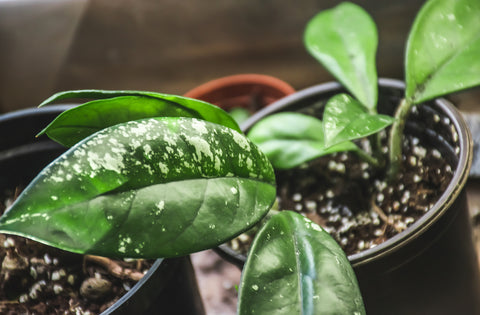
What is the best potting medium for Hoya?
When it comes to selecting a potting medium for Hoya plants, there is no one definitive answer. Many Hoya enthusiasts have their own preferred mixture, but using perlite and/or pumice is a popular choice among hobbyists. These natural products help to prevent soil compaction, improve drainage and root respiration, and maintain proper air and oxygen levels in the soil. It is important to use a porous soil mix that can retain moisture while still providing adequate drainage. A commonly recommended mixture is 20% chunky coco coir, 40% potting mix, 30% perlite and/or pumice, and 10% propagation sand. Another option that is frequently used by Hoya collectors is to use a chunky orchid mix and add perlite.
This mix allows the soil to hold onto moisture for a few days while draining excess water quickly. The perlite and pumice help maintain the structure of the soil and prevents compaction over time. It is important that the soil is light, so that oxygen can flow freely to the roots of the Hoya plant. If the roots don't receive enough oxygen, it may result in root rot. This type of soil mix is great for preventing this issue.
What is the best temperature for Hoya?
Hoyas grow well in average household humidity, with ideal room temperature between 15-25 degrees. Avoiding drafts and direct air from heating and cooling vents will help maintain the ideal temperature range. They are not tolerant to frost, so it's best to keep them indoors if you live in colder climates.
What is the best humidity for Hoya?
Most Hoya prefer a higher humid environment and will accelerate growth, but they can survive in 40-60% humidity which is the average household humidity. To artificially increase humidity, you can cluster plants together or keep a humidifier nearby.

Training Hoya onto a trellis
It is essential for the optimal growth of your Hoya plant to begin utilising a trellis and training clips as soon as possible. Some types of Hoya plants have a tendency to grow rapidly and may require the use of a trellis to keep them from becoming too unruly. Other varieties have stems that harden quickly, so it is advisable to shape and train them while they are still young to prevent stem breakage when trying to restrain them later on.
What's the best fertiliser for Hoya?
Originally developed for the Kew Royal Botanic Gardens in London, GT Orchid Focus is the international go-to for hoya hobbyists. It's the best product to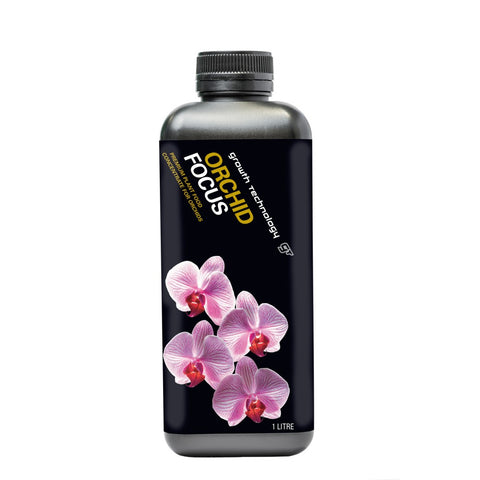 promote healthy growth and beautiful blooms.
promote healthy growth and beautiful blooms.
GT Orchid Focus:
- Includes calcium at higher levels hoyas need to prevent deficiencies.
- Free of chlorides! High-salt fertilisers are not good for hoyas.
- Urea-free! Using urea as the nitrogen source, the risk of fertiliser burn increases.
- PH of 6 which emulates the slightly acidic pH most hoya prefer.
- Contains all 12 essential minerals, at the correct levels Hoyas require to thrive.
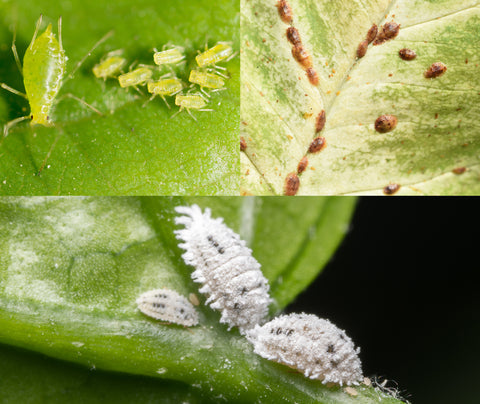
What are common Hoya pests and how you treat them?
Hoyas are known for their resilience against pests and diseases, however, there are a few common issues that should be monitored. Aphids, which are drawn to the sap of Hoya plants, are a common problem. Another common pest is mealybugs, which can be easily eliminated by using straight methylated spirits or isopropyl alcohol (70-99%), or by attracting natural predators such as lacewing and ladybugs. Scale insects can also be a problem, they appear as small blister-shaped domes that typically feed on the underside of new growth. To remove them, you can use a physical removal method or spray them with an insecticide. Additionally, when humidity is high, Hoyas can be susceptible to fungal diseases. To prevent this, it is important to ensure good airflow around the plant and use a systemic fungicide if necessary.
How to prune a Hoya
Avoid trimming the long tendrils! These plants have long, thin stems that eventually develop leaves and flower stalks.
To prune a Hoya, you should follow these steps:
-
First, identify the parts of the plant that need to be pruned. This may include dead or yellowing leaves, old flowers, or leggy growth.
-
Use a clean, sharp pair of scissors or pruning shears to make a clean cut just above a leaf node. This will encourage new growth to emerge from the node.
-
Be sure to prune the plant back to a healthy point, avoid cutting too close to the main stem.
-
When pruning leggy growth, it's best to cut back to a leaf node where new growth will emerge.
-
If you are pruning back the entire plant, you can cut back to 2-3 leaf nodes to encourage bushier growth.
-
After pruning, it's important to keep an eye on the plant and monitor for any signs of stress or disease. Keep the plant well-watered and fertilised, and make sure it has good light and airflow.
It's important to note that not all Hoya varieties require pruning and some may only need minimal pruning. It's best to research your specific variety to understand if and when it needs pruning.

How to propagate a Hoya
There are a few ways to propagate Hoya plants:
-
Stem Cuttings: Take stem cuttings from a healthy Hoya plant, making sure to cut just below a leaf node. Remove the leaves from the bottom half of the cutting, dip it in rooting hormone and let it dry out for a several hours before planting it in well-draining soil, moss or water to propagate. Keep the cutting in a warm and humid place, and wait for new growth to appear, which can take several weeks or even months.
-
Air Layering: Air layering is a method for propagating Hoya plants by encouraging roots to grow from the stem while it is still attached to the parent plant. To do this, make a small incision in the stem and cover it with a rooting hormone and wrap it with a plastic wrap and keep it moist. Once roots have formed, you can remove the rooted stem and pot it up.
It's important to note that not all Hoya varieties are easy to propagate and some may require more attention and care. It's best to research your specific variety to understand the best propagation method.
When do you need to repot a Hoya?
Hoyas prefer to be planted and kept in a snug pot. As they grow, they will eventually need to be re-potted to a larger size. Signs that it's time to repot include: needing to water more frequently, the roots are visible through the drainage holes, or the pot feels hard when squeezing the sides. The best time to repot is during the early spring.
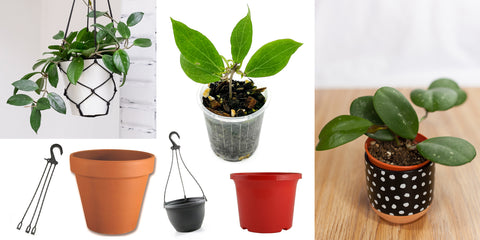
What sort of pot do Hoya like?
Hoya plants can be grown in a variety of pots, but there are a few things to keep in mind when choosing the right one:
-
Drainage: Hoya plants prefer well-draining soil, so it is important to choose a pot with drainage holes to prevent water from sitting in the bottom of the pot.
-
Size: The pot size should be appropriate for the size of the plant. A pot that is too small can restrict the plant's growth, while a pot that is too large can hold too much water and cause the roots to rot. Select a pot 3-5cm wider and deeper than the pot it is current in.
-
Material: Hoya plants can be grown in pots made of different materials, such as ceramic, plastic, and clay. Ceramic pots are heavy and not easy to move around. Plastic pots are lightweight and easy to move around, but they can retain moisture for long periods of time. Clay pots are porous, which allows for better air circulation around the roots, but they can dry out quickly.
-
Decorative pots: Hoyas can also be grown in decorative pots, such as hanging baskets. If you choose to use a hanging basket, make sure it has a good drainage system and that the plant is not over-crowded.
It's important to remember that Hoyas like to be slightly snug in their pots, so you don't need to repot them as often as other varieties of indoor plants. Also, the temperature of the pot can affect the temperature of the soil and the roots, so be mindful of where you place your pot, specially in cold climates.

What is sun-stressing Hoya?
A plant trend is 'sun-stressing' Hoyas. When they are exposed to more sunlight than they are accustomed to, they can change colour to protect their leaves, similar to how humans tan. If you are keen to try this, it's important to take it slow. Just like how humans need to build a base tan to avoid sunburns, Hoyas also need time to adjust. Gradual increase of light is the key.

How do you get a Hoya to bloom?
The timing of blooming for Hoya plants can be difficult to predict as it is dependent on the maturity of the plant. Growing conditions play a key role in determining when a Hoya will reach maturity. However, there is a belief that maintaining a tight root-bound environment by keeping the plant in a smaller pot than usual may lead to accelerated flowering. It is important to note that transferring the plant from a larger pot to a smaller one, known as down-potting, can cause stress to the Hoya and should be avoided in the plant care.
To encourage blooming, make sure your Hoya is comfortable in its pot, receiving good light, appropriate water, and fertiliser during the spring and summer. Give the plant time to grow into its pot and don't use a pot that's too big. Bright, indirect light is best, and a little direct sun is okay. Water when the soil is dry and use a fertiliser low in salts.
Another way to get your Hoya to bloom is by using the 'blooming stress method'. This involves withholding water for 4-5 weeks and giving the plant bright, indirect light. This method is best for thick-leaved varieties, but make sure to research the specific variety before trying it.
Are Hoyas toxic to pets and children?
While Hoyas can be a safe addition to a household with pets such as cats and dogs, it is important to keep in mind that they are not intended for consumption by either humans or animals. As a precaution, it is recommended to keep these plants out of reach of both pets and children.
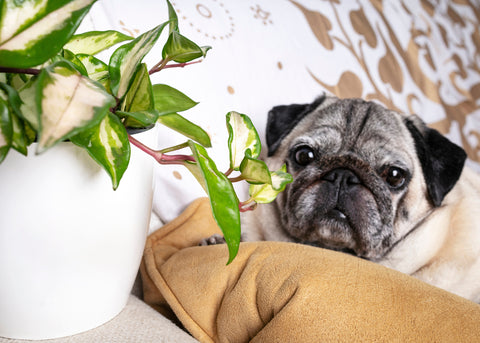











Comments
Dañìel Richards said:
My hoya’s are bùñch together should they be separated to let the air between them